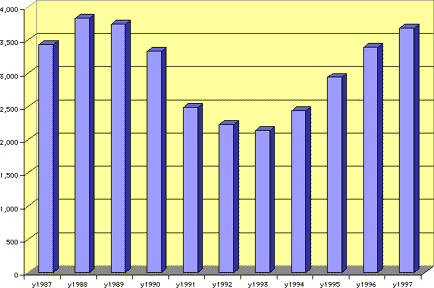|

SLOVAKIA
GDP (2008): $119.5 billion.
GDP growth rate (2008): 6.4%,
GDP per capita (2008): $21,900.
Unemployment (. 2008): 7.7%.
Budget: Income .............. $31.23 Billion
Expenditure ... $33.32 Billion
Main Crops: Grains, potatoes, sugar beets, hops, fruit; pigs, cattle, poultry; forest products.
Natural Resources: Brown coal and lignite; small amounts of iron ore, copper and manganese ore; salt .
Major Industries: Metal and metal products; food and beverages; electricity, gas, coke, oil, and nuclear fuel; chemicals and manmade fibers; machinery; paper and printing; earthenware and ceramics; transport vehicles; textiles; electrical and optical apparatus; rubber products .
|
| NATIONAL GNP |
 |
Since the establishment of the Slovak Republic in January 1993, Slovakia has continued the difficult transformation from a centrally planned economy to a modern market-oriented economy. This reform slowed in the 1994-98 period due to the crony capitalism and irresponsible fiscal policies of Prime Minister Vladimir Meciar's government. While economic growth and other fundamentals improved steadily during Meciar's term, public and private debt and trade deficits soared. Privatization, often tarnished by corrupt insider deals, progressed only in fits and starts. Real annual GDP growth peaked at 6.5% in 1995 but declined to 1.3% in 1999. Much of the growth in the Meciar era, however, was attributable to high government spending and over-borrowing rather than productive economic activity.
The economy grew 4.2% in 2003, the strongest growth in Central Europe, and is predicted to expand by more than 5% in 2004. Headline consumer price inflation dropped from 26% in 1993 to an average rate of 3.3% in 2002 but rose to 8.5% in 2003 as a result of increases in the subsidized prices of utilities ahead of SlovakiaŐs 2004 entry into the European Union. Inflation is projected to be 7.5% in 2004, dropping to 3% in 2005.
After economic stabilization in 1999 and 2000, Slovakia had several years of record current account deficits (8.8% of GDP in 2001 and 8.2% of GDP in 2002). This figure shrank rapidly in 2003 to USD 330 million (or 0.9% of GDP). A significant drop in the trade deficit accounted for most of this improvement; in 2003, SlovakiaŐs trade deficit fell 75% to USD 715 million, well below the most optimistic projections. SlovakiaŐs total foreign debt stood at USD 18.3 billion in December 2003 (up USD 5.2 billion from 2002 largely because of developments in the cross rate of the Euro against the USD).
Foreign direct investment (FDI) in Slovakia has increased dramatically. The Dzurinda government opened doors for foreign investors and introduced competitive incentives schemes, including a 19% flat income tax for corporations and individuals. Cumulative FDI has quintupled since the beginning of 2000 to USD 11.2 billion (June 2004). As of 2003, Slovakia has enjoyed per capita FDI of approximately $2,080.
In 2000, Slovakia became the thirtieth member of the OECD. More than 75% of its trade is with EU members, though Slovakia imports nearly all of its oil and gas from Russia. The country's export markets are primarily OECD and EU countries. Germany is Slovakia's largest trading partner, purchasing 30.5% of Slovakia's exports and supplying 24.8% of its imports in the first seven months of 2004. Other major partners include the Czech Republic (13.6% imports; 12.7% exports), Italy (6.2%; 6.4%), Russia (9.3%; 1.1%), and Austria (4.4%; 7.5%). The United States accounts for about 4% of total trade with Slovakia. |
|
|


